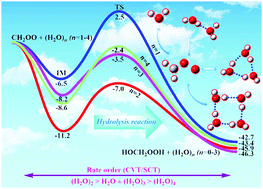The favorable routes for the hydrolysis of CH2OO with (H2O)n (n = 1–4) investigated by global minimum searching combined with quantum chemical methods†
Abstract
The hydrolysis reaction of CH2OO with water and water clusters is believed to be a dominant sink for the CH2OO intermediate in the atmosphere. However, the favorable route for the hydrolysis of CH2OO with water clusters is still unclear. Here global minimum searching using the Tsinghua Global Minimum program has been introduced to find the most stable geometry of the CH2OO⋯(H2O)n (n = 1–4) complex firstly. Then, based on these stable complexes, favorable hydrolysis of CH2OO with (H2O)n (n = 1–4) has been investigated using the quantum chemical method of CCSD(T)-F12a/cc-pVDZ-F12//B3LYP/6-311+G(2d,2p) and canonical variational transition state theory with small curvature tunneling. The calculated results have revealed that, although the contribution of CH2OO + (H2O)2 is the most obvious in the hydrolysis of CH2OO with (H2O)n (n = 1–4), the hydrolysis of CH2OO with (H2O)3 is not negligible in atmospheric gas-phase chemistry as its rate is close to the rate of the CH2OO + H2O reaction. The calculated results also show that, in a clean atmosphere, the CH2OO + (H2O)n (n = 1–2) reaction competes well with the CH2OO + SO2 reaction at 298 K when the concentrations of (H2O)n (n = 1–2) range from 20% relative humidity (RH) to 100% RH, and SO2 is 2.46 × 1011 molecules per cm3. Meanwhile, when the RH is higher than 40%, it is a new prediction that the CH2OO + (H2O)3 reaction can also compete well with the CH2OO + SO2 reaction at 298 K. Besides, Born–Oppenheimer molecular dynamics simulation results show that all the favorable channels of the CH2OO + (H2O)n (n = 1–3) reaction cannot react on a time scale of 100 ps in the NVT simulation. However, the NVE simulation results show that the CH2OO + (H2O)3 reaction can be finished well at 8.5 ps, indicating that the gas phase reaction of CH2OO + (H2O)3 is not negligible in the atmosphere. Overall, the present results have provided a definitive example of how the favorable hydrolysis of important atmospheric species with (H2O)n (n = 1–4) takes place, which will stimulate one to consider the favorable hydrolysis of water and water clusters with other Criegee intermediates and other important atmospheric species.



 Please wait while we load your content...
Please wait while we load your content...